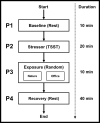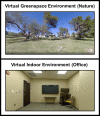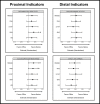Susceptibility to stress and nature exposure: Unveiling differential susceptibility to physical environments; a randomized controlled trial
- PMID: 38630650
- PMCID: PMC11023441
- DOI: 10.1371/journal.pone.0301473
Susceptibility to stress and nature exposure: Unveiling differential susceptibility to physical environments; a randomized controlled trial
Abstract
Background: Emerging epidemiological evidence indicates nature exposure could be associated with greater health benefits among groups in lower versus higher socioeconomic positions. One possible mechanism underpinning this evidence is described by our framework: (susceptibility) adults in low socioeconomic positions face higher exposure to persistent psychosocial stressors in early life, inducing a pro-inflammatory phenotype as a lifelong susceptibility to stress; (differential susceptibility) susceptible adults are more sensitive to the health risks of adverse (stress-promoting) environments, but also to the health benefits of protective (stress-buffering) environments.
Objective: Experimental investigation of a pro-inflammatory phenotype as a mechanism facilitating greater stress recovery from nature exposure.
Methods: We determined differences in stress recovery (via heart rate variability) caused by exposure to a nature or office virtual reality environment (10 min) after an acute stressor among 64 healthy college-age males with varying levels of susceptibility (socioeconomic status, early life stress, and a pro-inflammatory state [inflammatory reactivity and glucocorticoid resistance to an in vitro bacterial challenge]).
Results: Findings for inflammatory reactivity and glucocorticoid resistance were modest but consistently trended towards better recovery in the nature condition. Differences in recovery were not observed for socioeconomic status or early life stress.
Discussion: Among healthy college-age males, we observed expected trends according to their differential susceptibility when assessed as inflammatory reactivity and glucocorticoid resistance, suggesting these biological correlates of susceptibility could be more proximal indicators than self-reported assessments of socioeconomic status and early life stress. If future research in more diverse populations aligns with these trends, this could support an alternative conceptualization of susceptibility as increased environmental sensitivity, reflecting heightened responses to adverse, but also protective environments. With this knowledge, future investigators could examine how individual differences in environmental sensitivity could provide an opportunity for those who are the most susceptible to experience the greatest health benefits from nature exposure.
Copyright: © 2024 Eisen et al. This is an open access article distributed under the terms of the Creative Commons Attribution License, which permits unrestricted use, distribution, and reproduction in any medium, provided the original author and source are credited.
Conflict of interest statement
The authors have declared that no competing interests exist.
Figures





References
Publication types
MeSH terms
Substances
Grants and funding
LinkOut - more resources
Full Text Sources
Medical

